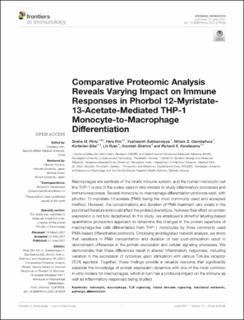| dc.contributor.author | Pinto, Sneha M. | |
| dc.contributor.author | Kim, Hera | |
| dc.contributor.author | Subbannayya, Yashwanth | |
| dc.contributor.author | Giambelluca, Miriam S. | |
| dc.contributor.author | Bösl, Korbinian | |
| dc.contributor.author | Ryan, Liv | |
| dc.contributor.author | Sharma, Animesh | |
| dc.contributor.author | Kandasamy, Richard Kumaran | |
| dc.date.accessioned | 2021-09-20T06:09:17Z | |
| dc.date.available | 2021-09-20T06:09:17Z | |
| dc.date.created | 2021-07-22T13:53:12Z | |
| dc.date.issued | 2021 | |
| dc.identifier.citation | Frontiers in Immunology. 2021, 12 1-16. | en_US |
| dc.identifier.issn | 1664-3224 | |
| dc.identifier.uri | https://hdl.handle.net/11250/2778979 | |
| dc.description.abstract | Macrophages are sentinels of the innate immune system, and the human monocytic cell line THP-1 is one of the widely used in vitro models to study inflammatory processes and immune responses. Several monocyte-to-macrophage differentiation protocols exist, with phorbol 12-myristate-13-acetate (PMA) being the most commonly used and accepted method. However, the concentrations and duration of PMA treatment vary widely in the published literature and could affect the probed phenotype, however their effect on protein expression is not fully deciphered. In this study, we employed a dimethyl labeling-based quantitative proteomics approach to determine the changes in the protein repertoire of macrophage-like cells differentiated from THP-1 monocytes by three commonly used PMA-based differentiation protocols. Employing an integrated network analysis, we show that variations in PMA concentration and duration of rest post-stimulation result in downstream differences in the protein expression and cellular signaling processes. We demonstrate that these differences result in altered inflammatory responses, including variation in the expression of cytokines upon stimulation with various Toll-like receptor (TLR) agonists. Together, these findings provide a valuable resource that significantly expands the knowledge of protein expression dynamics with one of the most common in vitro models for macrophages, which in turn has a profound impact on the immune as well as inflammatory responses being studied. | en_US |
| dc.language.iso | eng | en_US |
| dc.publisher | Frontiers Media | en_US |
| dc.rights | Navngivelse 4.0 Internasjonal | * |
| dc.rights.uri | http://creativecommons.org/licenses/by/4.0/deed.no | * |
| dc.title | Comparative Proteomic Analysis Reveals Varying Impact on Immune Responses in Phorbol 12-Myristate-13-Acetate-Mediated THP-1 Monocyte-to-Macrophage Differentiation | en_US |
| dc.type | Journal article | en_US |
| dc.type | Peer reviewed | en_US |
| dc.description.version | publishedVersion | en_US |
| dc.source.pagenumber | 1-16 | en_US |
| dc.source.volume | 12 | en_US |
| dc.source.journal | Frontiers in Immunology | en_US |
| dc.identifier.doi | 10.3389/fimmu.2021.679458 | |
| dc.identifier.cristin | 1922425 | |
| dc.relation.project | Regionalt helseforetak: 90414000 | en_US |
| dc.relation.project | Norges forskningsråd: 263168 | en_US |
| dc.relation.project | Norges forskningsråd: 223255/F50 | en_US |
| cristin.ispublished | true | |
| cristin.fulltext | original | |
| cristin.qualitycode | 1 | |

